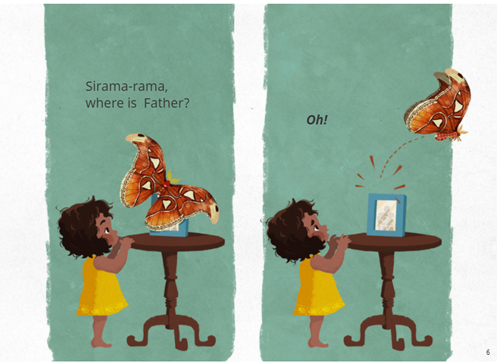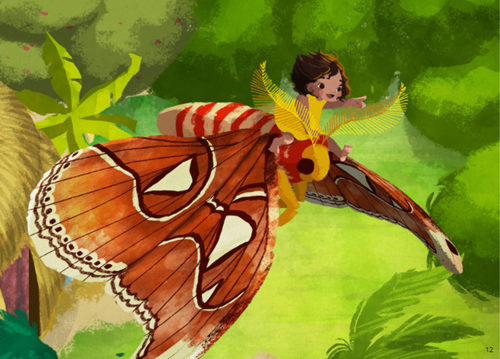Alisha Niehaus Berger writes about the power of globally diverse children's books
September 21, 2020
Alisha Niehaus Berger, Global Children's Book Publisher and Director, Literacy, for Room to Read writes on diverse books.
A little girl flings open the curtain door of her home in rural Indonesia. Her mother is drying fish in their yard—and an Atlas moth, known locally as a sirama-rama, flits by. Many Indonesians believe that when a sirama-rama arrives, it means someone you love will soon be near…and our little girl has been waiting for her father to return from his far-away job for almost a year. She follows the moth on an adventure, real and imaginary, until she can embrace him in a welcome-home hug.
In Indonesia, and across Southeast Asia, the Middle East, and beyond, millions of children have parents who work abroad in wealthier countries. I never thought much about this until I first read Sirama-rama, a book Room to Read co-published, and felt the little girl's loss and hope reverberate in my heart. In fact, I never considered many of the unique challenges of children across the world until I read about them in the books we publish.

Today in the U.S., the cry for diverse children’s books is finally being heard. The lack of books written by the diverse populations themselves (often called “own voices” books) is a shameful issue deeply entrenched in publishing, and one that is slowly beginning to change. Thanks to talented diverse storytellers and organizations like We Need Diverse Books, many American children are starting to find their lives and experiences reflected in the pages of books. But there is another glaring gap on the bookshelves of American children. I am talking about the dearth of globally diverse voices.
Room to Read strives to end illiteracy and gender inequality. Part of our mission is to build sustainable local publishing industries in low-income communities by training, publishing, and promoting the work of local authors, illustrators, and publishers. Since 2003, we have published nearly 1600 children’s books in 42 languages and 16 countries. In fact, we have now uploaded many of our books online to enjoy for free on LiteracyCloud.org. You can even read an English translation of Sirama-rama here.

We seek to empower children with stories relevant to the issues they face. For example, Sirama-rama is one of several takes on the single-parent childhoods so common in Southeast Asia. We publish stories by Syrian refugees, and about childhood topics other than loss, stories of global trash washing up on Vietnamese shores. We also publish books that are mirrors of daily life in the communities we serve: what it’s like to pilot your own boat to school, to have parents who can’t read, to have to miss your soccer game because your mother needs you to make sure the beef jerky dries properly. But these global books are just beginning to reach U.S. audiences.
Many factors contribute to the lack of global “own voices” in our children’s books. In many of the countries in which Room to Read works, writers and artists lack exposure to the vibrant and eclectic world of children’s books, as by and large they did not grow up with a single picture book. Small publishers face myriad political and economic obstacles to creating books in the first place, let alone in promoting them at international book fairs.
Personally, I find the most discouraging obstacle between global books and your bookshelf is the perceived lack of salability of anything “international” in the U.S. market. When I was a children’s book editor in New York, I tried to publish books from other countries. The obstacles were myriad: the additional cost of a translator, little in-house enthusiasm, meager sales projections. “This art is too European,” was a common refrain.
Even now, most of the international children’s books that do exist here are written by white U.S. citizens and by immigrants who have left their home countries to live in the U.S. American children rarely get to read the voices of people who live outside America.
Yet in the current political climate, what could be more important than exposing children to books that reveal global voices on their own terms? Books that grow global citizens by increasing empathy for different points of view? The places and people across the world who are missing from our children’s storybooks may seem far away, but we cannot deny that their concerns—political, environmental, human—are also our concerns. The time is now for readers, librarians, and parents to demand “own voices” stories from across the world.
I want to take my children into our local bookstore and find not only incredible books by Yuyi Morales, Christian Robinson, and Traci Sorell, but by Maria Jose Montesinos, Kim Hai, and Hiyam Ada Adas. What a day it will be when we can celebrate the full breadth of diverse books.
